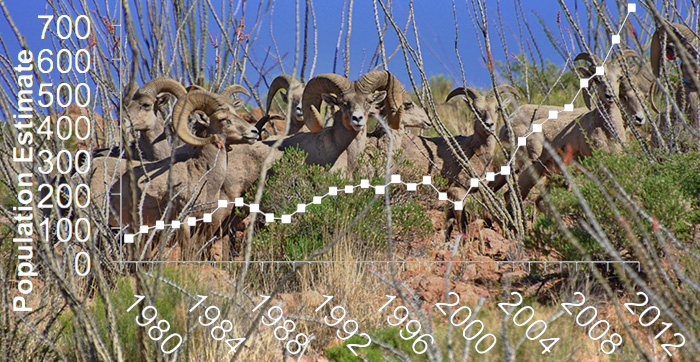
Desert Bighorn Sheep and Cougar Management Math
Desert bighorn sheep are a valuable species of wildlife both as a big game trophy and as watchable wildlife. They are an amazing animal supremely adapted to a harsh environment. The sight of a herd of rams running up a steep rocky slope exemplifies the meaning of wild places and the power of habitat conservation. Through active management and conservation measures, wildlife biologists have successfully recovered this sensitive species so that is no longer endangered in New Mexico.
Overview

New Mexico’s wildlife biologists successfully recover a previously endangered species – Desert bighorn sheep.
Overview: Students study wildlife management data (in the form of tables and graphs) from cougar and desert bighorn sheep studies done in New Mexico. Students read informational text and learn new vocabulary related to wildlife management and bighorn sheep. Students use this data in their science journals to make calculations and create tables and graphs. Students make reasonable predictions from this data as to the future of desert bighorn sheep populations.
Grade level: 6th-7th grade
Content Areas: Science, math, language, arts/writing
Method: Students read and discuss information about desert bighorn sheep and then analyze data in tables and graphs and make mathematical calculations. Students answer questions based on the information presented and make reasonable inferences about desert bighorn sheep populations in New Mexico. Students take part in group discussions and write in their science notebooks.
Materials for Introduction of Lesson:
Science notebooks
writing tools
Lesson and Activity Time: 2-3 classroom sessions
Location: Indoors
Common Core Standards:
Mathematics:
Grade 4-Numbers and Operations-Fractions-NF.1,2,3d. Measurement and Data-MD.4.Grade 5-Geometry-G.1,2.
Grade 6- Ratios and Proportional Relationships-RP.1,2,3.
New Mexico Life Science Standards:
Grade 5: Strand II. Standard II: Life Science. Benchmark I: Performance Standards: 1-4.
Grade 6: Performance Standards:1,3.
Background
Vocabulary: predator, prey, adaptations, habitat, food web, extinct
Science Concepts presented: Predator prey relationships, adaptations, needs of wildlife for healthy habitat, food web, wildlife management, mortality, drought, extirpation.
Background: While desert bighorn sheep currently live in the American Southwest and Mexico, there are not nearly as many as there were historically. What was once several thousand desert bighorn sheep in New Mexico, declined until they almost went extinct in the early 1900s. Commercial hunting, over-grazing, and diseases from livestock (which they have no resistance to) were the principal causes of decline. By 1955 desert bighorn sheep were only found in two separate mountain ranges in New Mexico, and by 1980 they numbered less than 100 individuals. In 1980 they were added to the state endangered species list.
Numbers went up and down over the next 20 years, rising to over 200 in the 1990s, but dropping to less than 170 by 2001. In 1999 an important decision was made that would end up saving desert bighorn sheep from disappearing in New Mexico. The Department of Game and Fish knew that cougars were the primary cause for the low numbers of desert bighorn sheep. In one study, biologists found that 85% of the radio-collared bighorn sheep biologists that died were killed by cougars. Between 1996-2002, the number of distinct, wild populations of desert bighorn sheep went from 7 to 4 following the extinction of the Alamo Hueco, Animas Mountains, and San Andres Mountains herds. Historically, desert bighorn were in at least 14 mountain ranges in central and southern New Mexico!
Something had to be done to stop the loss of more populations and possibly the complete disappearance of desert bighorn sheep from New Mexico. The decision was made to start removing some cougars from where desert bighorn sheep lived. Removal of cougars began in 1999 but successful efforts did not start until 2001. Since desert bighorn sheep were not being attacked and eaten by cougars so frequently, their numbers increased drastically. Cougars still are there in desert bighorn sheep habitat but at lower levels than would occur without predator control methods such as snaring and trapping. Cougar control is critical but is just one of many wildlife management tools used to protect desert bighorn sheep.
The sharp increase in bighorn sheep led to their down-listing to threatened status in 2008 and their removal from threatened status in 2012.
Procedure
Lesson:
1. Check out the Bighorn Sheep Critter Box from the New Mexico Department of Game and Fish. View ram skull. Show students photos from the Critter Box or on the Department website. Students write in their science notebooks what they know already about bighorn sheep.
2. Present students with background information on the life history of desert bighorn sheep.
See [wpfilebase tag=file id=748 tpl=filebrowser /].
NOTE: Teachers may need to work with students to read and understand the Wildlife Note. Educators can view these articles on the NM Dept Game and Fish website:
– [wpfilebase tag=file id=1567 tpl=filebrowser /], Eric M. Rominger, Elise J. Goldstein, New Mexico Department of Game and Fish, 2009.
– [wpfilebase tag=file id=1568 tpl=filebrowser /], New Mexico Department of Game and Fish, March 26, 2010.
– [wpfilebase tag=file id=1934 tpl=filebrowser /], Eric Rominger, Ph.D., Boone and Crockett Club’s “Fair Chase” magazine.
3. Share with students that the desert bighorn sheep is on a positive trend towards recovery and is no longer an endangered species in New Mexico. It has been a long road and has taken a lot of work with ‘boots on the ground’ but wildlife management activities have proven again to be a successful model for wildlife conservation.
4. Divide the class into small groups. Groups select a category (description, feeding behavior and breeding, population trends, and conservation) of natural history on desert bighorn sheep to research and report back to the class. Students can use online resources and the handouts provided in the activity to do their research.
Read the [wpfilebase tag=file id=748 tpl=filebrowser /] Wildlife Note.
Students can use different online software resources such as Prezi, Glogster, or Google Spreadsheets to create a multi-media presentation on their category. Visit International Society for Technology Education website (www.iste.org) for more multi-media resources for student presentations.
5. After class presentations, lead a class discussion on the overall natural history of desert bighorn sheep, using the categories described above. NOTE: It will be helpful for students to understand predator-prey relationships, and the role of wildlife management in maintaining healthy populations of threatened species.
6. Go over directions with the class for the student Worksheet A (below) and hand out. This sheet contains two sets of numbers; the years 1980-2012 and the corresponding annual population of desert bighorn sheep. Note: All data presented is from actual research by Department bighorn sheep biologists.
[wpfilebase tag=file id=1904 tpl=filebrowser /]a) Students create a graph in science journals (with x and y axis) for years 1980-2012 with the corresponding number of bighorn sheep.
b) Using their science journals, have groups answer questions based on Worksheet A.
i. What is the overall trend for desert bighorn sheep population numbers? Which year is the start of a sharp decline in overall bighorn sheep numbers?
ii. Are all parts of the graph the same?
iii. Which year is the start of a significant, notable increase in sheep numbers?
7. Hand out Worksheet B (below) that has the graph with the following additional information on how many sheep were released before and after 2001: “Total number of bighorn sheep released into all historic desert bighorn sheep habitat from 1980-2001 was 249, from 2001-2012 there were 231 bighorn sheep released.”
[wpfilebase tag=file id=1908 tpl=filebrowser /]Suggested questions for students to address:
a) What might be some possible reasons for the dramatic rise in bighorn sheep after 2001?
b) How many fewer bighorn sheep were released from 2001-2012 than from 1980-2001?
8. Present Worksheet C (below) with the same graph from Worksheets A and B but now showing when the Department started an intensive cougar removal program from mountain ranges where bighorn sheep lived in 2001.
[wpfilebase tag=file id=1907 tpl=filebrowser /]9. Present Table 1, ‘Average Annual Desert BHS Death Rate 1999-2012’.
[wpfilebase tag=file id=1906 tpl=filebrowser /]Background Information: In 2001 intensive cougar removal began in desert bighorn sheep habitat primarily through snaring, trapping and hunting. From 2001-2012, the state-wide bighorn sheep population increased from less than 170 to over 750. This recovery, after decades of stable or declining population, is a result of removing cougars from those mountain ranges. The bighorn sheep were better able to survive without so many cougar preying on them. This lower mortality (death) rate allowed the transplanting of bighorn sheep to be more successful in increasing their overall numbers. This amazing population increase has taken place during a prolonged drought that has affected much of the southwestern United States, including New Mexico.
Transplanting Desert Bighorn Sheep: In 1972 the Department established a captive herd of desert bighorn sheep north of Lordsburg from 22 animals in the San Andres Mountains and from Sonora, Mexico. A large (over 1,500 acres) fenced area called Red Rock Wildlife Area is home to bighorn sheep who roam freely over cliffs, canyons, springs and rocky slopes. They feed on natural vegetation and are often exposed to natural predators. The herd is allowed to grow no larger than 100 animals, allowing for periodic transplants to other areas. Until wild populations are large enough to be used a source of animals, Red Rock will be the foundation of our desert bighorn sheep restoration program. From 2002-2011 over 230 bighorn sheep were transplanted into the wild. There were only four years where there were not any bighorn sheep being transplanted into the wild.
Have students answer:
a) Calculate the ratio of the average annual mortality rate when there was no protection (0.16) from cougar predation to the period after cougar removal started (0.06).
b) How much, approximately, did cougar predation of bighorn sheep drop after cougar removal? 1/4, 1/3, 1/2, more than 1/2?
c) What is the difference in cougar predation rates for bighorn sheep males versus females? Is it higher for males or lower? Why might there be a difference?
Background Information: Elise Goldstein, former New Mexico Department of Game and Fish, Bighorn Sheep biologist says, “Cougar predation on males is less than on females is likely because rams are bigger and stronger and therefore have a better ability to fight off a cougar attack. It seems reasonable that in turn cougars might attempt to attack rams less often because they know that they do not have as good a chance of killing a rams, but I cannot prove that. This is interesting because rams live in gentler habitat that is further from cliffs which makes them more exposed than ewes, but our data suggest that it does not make them more vulnerable to predation.” Personal communication, March 28, 2013.
10. Wildlife management activities in New Mexico are paid, in part, through hunting license sales. Hunters often go to great lengths to pursue bighorn sheep in remote, rugged wilderness areas. (For more information on wilderness areas for New Mexico and across the country visit: www.wilderness.net). Bighorn sheep rams often have large horns that are scored and rated with others. The Boone and Crocket Club (www.boone-crockett.org) has the rating system that is most often used in scoring big game animals. Funding also comes from creative partnerships with wildlife conservation groups like the Wild Sheep Foundation (www.wildsheepfoundation.org) out of Cody, WY. The Department gives them one bighorn sheep license tag every year to auction off at their annual convention. Since 1990, they run a live auction where hunters bid on the chance to hunt a New Mexico bighorn sheep. The Wild Sheep Foundation in turn, hands over 90 percent of the proceeds (money) to help fund the bighorn sheep wildlife management program in New Mexico.They also conduct a raffle where tickets are sold and a drawing held to determine one lucky winner of a bighorn sheep license tag. See Table 2, “New Mexico Bighorn Sheep Enhancement Fund, 1990-2012, NMDGF.”
[wpfilebase tag=file id=1905 tpl=filebrowser /]11. Based on Table 2 (above) have student groups answer these questions:
-If raffle tickets are $20.00 each then how many tickets were sold in 2012? What year had the fewest tickets sold? What year had the most tickets sold?
-How much money does the Department get from each ticket sold?
-What is the average, mean and median of the total raffle earnings since 1999?
-What are the total auction earnings since 1990 to the Department?
-What is the average, mean and median of the auction proceeds since 1990?
Extension
Assessment:
1. Students write their prediction for the future of bighorn sheep population numbers in New Mexico.
a) Do they think that populations will continue to expand? What do they think the total number of bighorn sheep will be in 1 year? 2 years? 3 years? 5 years? 10 years?
b) What if cougar control is halted in those mountain ranges where desert bighorn sheep live in New Mexico? What would they predict would happen to desert bighorn sheep populations over the same time span? Why? What other factors might influence desert bighorn sheep populations?
NOTE: In 2015, there are not any desert bighorn sheep populations in New Mexico large enough to consider reducing the level of cougar control now in place. Signs of cougar are still found every year in every mountain range where desert bighorn sheep live. This shows that the cougar control program has not eliminated (extirpated) cougars from any mountain range.
2. Have students read the description of the Department bighorn sheep biologists. Ask student groups to answer the following questions:[wpfilebase tag=file id=1901 tpl=simple /]
a. Would you like to have such a job? Why or why not?
b. What kinds of activities or equipment do you think the money earned from the hunting raffle and auction is used for?
3. Students work in small groups to discuss what they learned from the activity or any ideas they might have that came from the activity
[wpfilebase tag=file id=1903 tpl=simple /]
